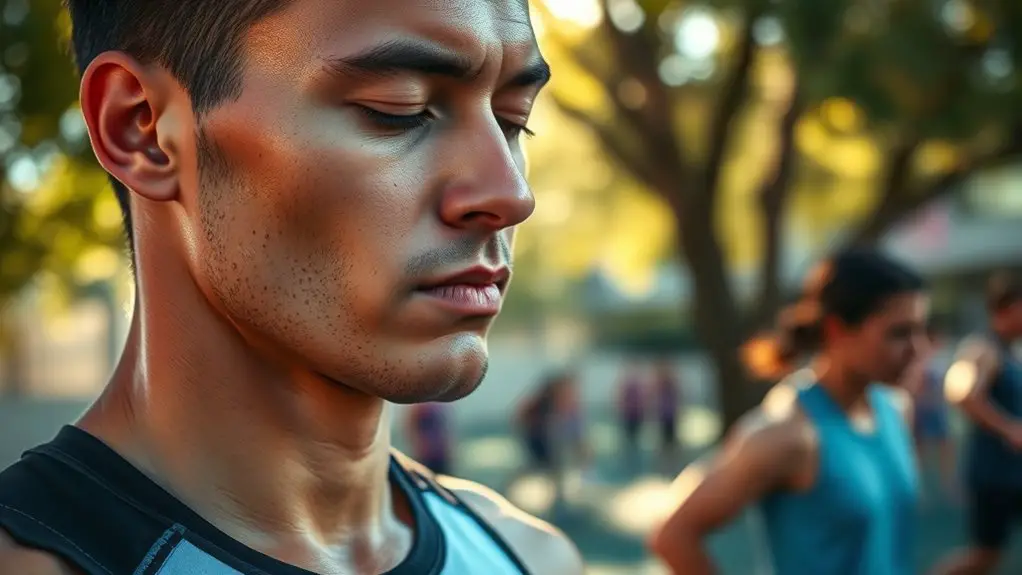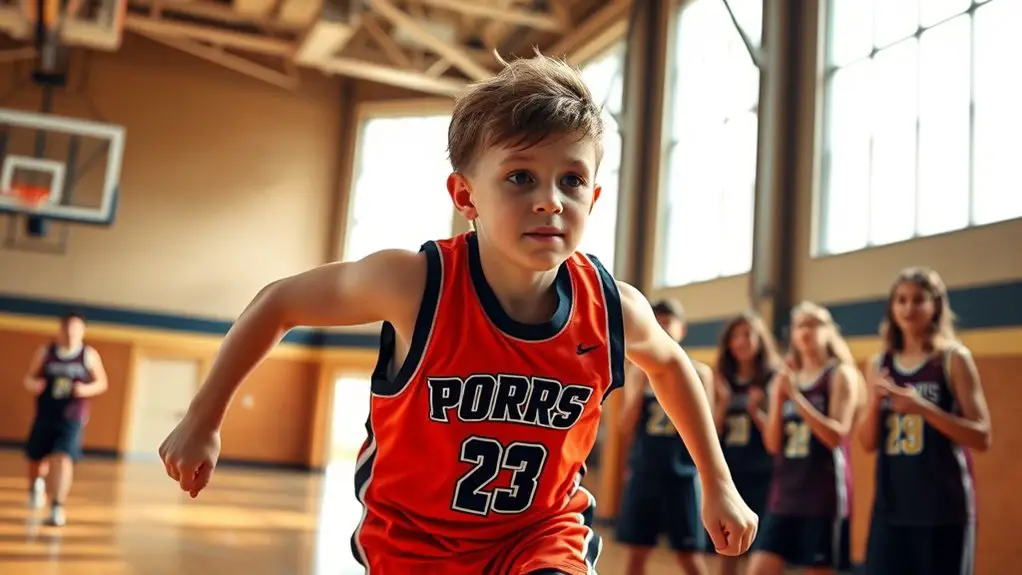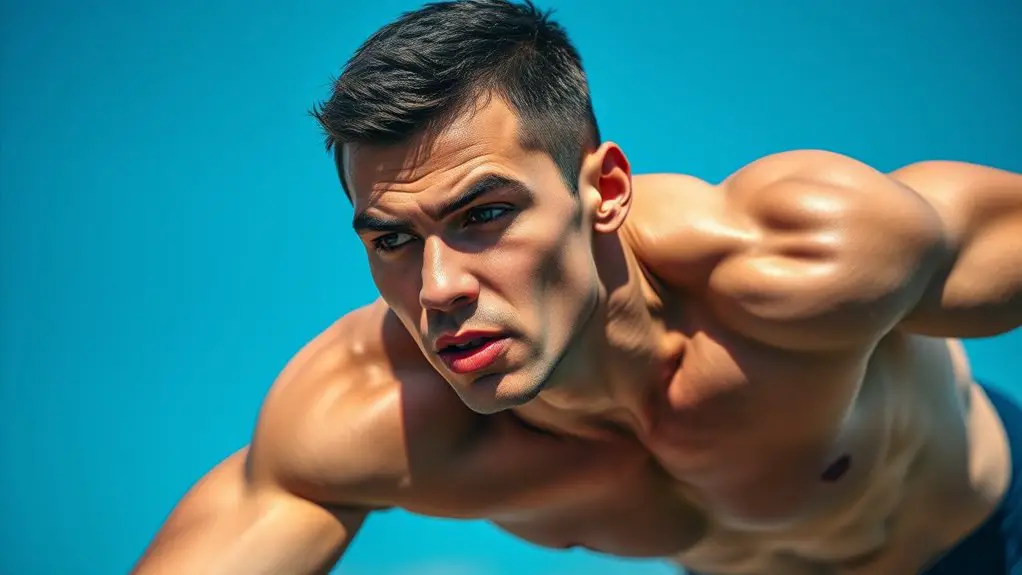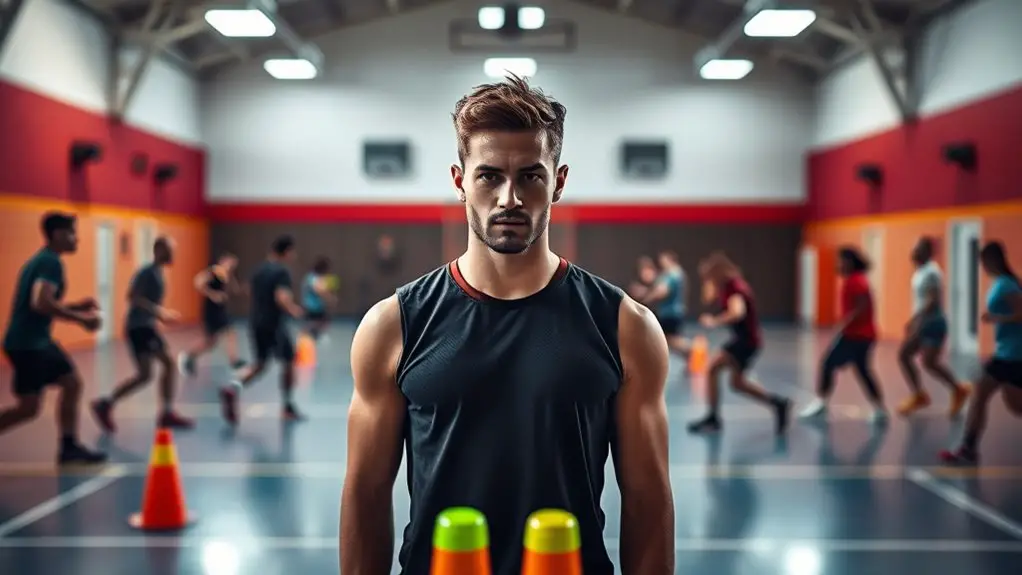Breathing techniques enhance your athletic focus by promoting calmness and mental clarity. When you practice deep, steady breathing, you signal your brain to relax, helping you manage stress and anxiety during competitions. Techniques like diaphragmatic and box breathing boost oxygen flow and concentration, keeping you grounded and present. By integrating these methods into your routine, you'll notice improved performance under pressure. Discover various techniques that could elevate your game even further.
The Science Behind Breathing and Focus
When you're in the heat of competition, the way you breathe can greatly impact your focus and performance. Your breath isn't just a bodily function; it's a powerful tool that can steer your mind. When you breathe deeply and steadily, you're sending signals to your brain that everything's okay. This helps you stay calm and centered, allowing for clearer thinking and better decision-making. Conversely, shallow or rapid breathing can trigger anxiety, clouding your judgment. By understanding this connection, you can harness your breath to release your full potential. Mastering your breath means mastering your mind. So, take a moment before you immerse yourself in action, and remember: the freedom to perform starts with the rhythm of your breath.
Types of Breathing Techniques for Athletes
Breathing techniques play an essential role in maximizing athletic performance. By mastering various methods, you can enhance your focus and endurance. Here are four types of breathing techniques you might find beneficial:
Mastering breathing techniques can significantly enhance your focus and endurance, essential for maximizing athletic performance.
- Box Breathing: This involves inhaling, holding, exhaling, and holding again for equal counts, helping to calm your mind.
- Pursed Lip Breathing: Breathe in through your nose and exhale slowly through pursed lips, which can improve ventilation and decrease breathlessness.
- Nasal Breathing: Inhale and exhale through your nose to boost oxygen intake and promote relaxation during intense activity.
- Rhythmic Breathing: Synchronizing your breath with your movements can enhance your performance and maintain your focus throughout your workout.
Try incorporating these techniques into your routine for greater freedom and control!
Diaphragmatic Breathing: A Foundation for Focus
Understanding various breathing techniques sets the stage for exploring diaphragmatic breathing, a method that forms the foundation for enhancing focus. This technique involves taking deep breaths through your diaphragm rather than shallow breaths with your chest. When you breathe deeply, you increase oxygen flow, boosting your energy and mental clarity. It helps you feel grounded, allowing you to tune into your body and the present moment. As you practice diaphragmatic breathing, you'll notice a shift in your ability to concentrate and perform under pressure. Embracing this simple yet powerful technique can release you from distractions, creating a clear path to your athletic goals. So, take a moment to breathe deeply, and access your full potential.
Box Breathing: Managing Stress and Anxiety
Box breathing, also known as square breathing, is a powerful technique for managing stress and anxiety, especially in high-pressure athletic situations. It helps you regain control and sharpen your focus. Here's how to practice it:
- Inhale for a count of four, filling your lungs completely.
- Hold your breath for another count of four, creating stillness.
- Exhale for a count of four, releasing tension.
- Hold your breath again for four counts before starting the cycle over.
4-7-8 Breathing: Enhancing Performance Through Relaxation
After mastering box breathing for stress management, you can explore 8-breathing to further enhance your athletic performance through relaxation. This technique involves inhaling for a count of four, holding for a count of four, and exhaling for a count of eight. By extending your exhale, you promote a sense of calm, allowing your body to recover and rejuvenate. This deeper state of relaxation can help release tension, making it easier to focus on your movements. It's about giving yourself the freedom to connect with your body, letting go of distractions. Integrating 8-breathing into your routine can enhance your endurance and clarity, paving the way for peak performance when it counts the most. Embrace this powerful tool for relaxation.
The Role of Breathing in Mindfulness and Concentration
As you engage in athletic activities, the breath becomes a powerful anchor for mindfulness and concentration. When you focus on your breathing, you can enhance your performance and clarity. Here's how:
- Grounding: Deep breaths keep you present, reducing distractions.
- Calming: Controlled breathing helps to lower anxiety, allowing for a serene mind.
- Energizing: Inhaling deeply can boost oxygen flow, fueling your body and spirit.
- Centering: Consistent breath patterns help maintain a steady rhythm, aligning your mind and body.
Breathing Techniques in Different Sports
While each sport presents unique demands, effective breathing techniques can enhance performance across the board. Whether you're sprinting, swimming, or practicing yoga, mastering your breath helps maintain focus and energy. Here's a quick look at how different sports utilize breathing:
| Sport | Technique | Benefit |
|---|---|---|
| Running | Diaphragmatic breathing | Increases oxygen intake |
| Swimming | Bilateral breathing | Enhances stroke efficiency |
| Yoga | Ujjayi breathing | Promotes relaxation and focus |
| Weightlifting | Valsalva maneuver | Stabilizes core during lifts |
| Martial Arts | Controlled exhalation | Enhances timing and precision |
Practical Tips for Incorporating Breathing Techniques
Incorporating effective breathing techniques into your training routine can greatly enhance your athletic performance. Here are some practical tips to help you get started:
- Practice Diaphragmatic Breathing: Focus on deep belly breaths rather than shallow chest breathing to improve oxygen intake.
- Use Breathing Cues: During workouts, remind yourself to breathe in sync with your movements, like inhaling during preparation and exhaling on exertion.
- Set Aside Time: Dedicate a few minutes before or after training to practice your breathing techniques, helping you center your focus.
- Incorporate Mindfulness: Try meditative breathing sessions to enhance mental clarity and reduce stress, which can improve your overall performance.
Once you integrate these techniques, you'll likely feel more centered and ready to reach your athletic goals.
Success Stories: Athletes Who Utilize Breathing Techniques
How do elite athletes maintain their focus under pressure? Many turn to breathing techniques for that edge. Take NBA superstar LeBron James, who uses controlled breathing to calm his mind during high-stakes moments. By focusing on his breath, he's able to block out distractions and elevate his game. Similarly, Olympic swimmer Michael Phelps credits his breathing routines for enhancing his concentration in the pool, allowing him to swim with freedom and precision. You can find inspiration in these success stories and realize that mastering your breath can transform your performance. Whether you're on the court or in the pool, integrating these techniques can help you release your true potential, giving you the focus needed to thrive when it matters most.
Frequently Asked Questions
How Long Does It Take to See Results From Breathing Techniques?
Like a seed sprouting in spring, you might start feeling results from breathing techniques within a few weeks. Consistency's key, so give it time; soon you'll reveal a newfound sense of freedom and clarity.
Can Breathing Techniques Be Used in Non-Athletic Situations?
Absolutely, you can use breathing techniques in everyday situations. They help reduce stress, improve focus, and promote relaxation. Whether at work or home, these techniques can enhance your overall well-being and mental clarity.
Are There Any Risks Associated With Breathing Techniques?
Sure, you might think breathing techniques are foolproof, but they can actually lead to dizziness or hyperventilation if done incorrectly. It's essential you listen to your body and practice them mindfully to avoid potential risks.
How Do Breathing Techniques Differ Between Athletes and Non-Athletes?
Breathing techniques vary between athletes and non-athletes mainly in intensity and purpose. Athletes focus on performance enhancement and recovery, while non-athletes often use them for relaxation and stress relief. You can benefit from both approaches!
What Resources Are Available for Learning Breathing Techniques?
Imagine a serene space where your breath flows like a gentle stream. You can find resources like online courses, apps, and instructional videos that guide you in mastering breathing techniques, releasing your potential for freedom and focus.




